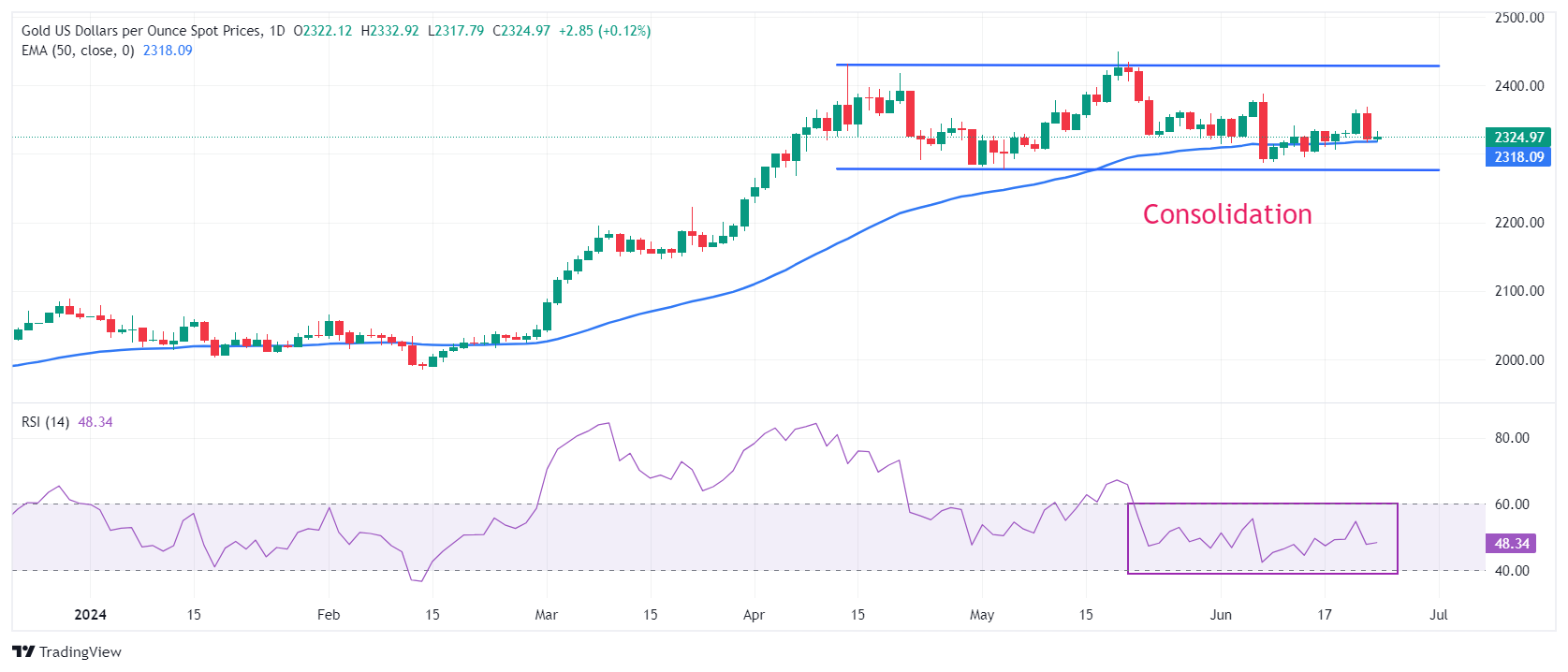Gold price rebounds from $2,315 as US Dollar comes under pressure on Monday.
Investors see the Fed reducing interest rates twice this year.
The US economic outlook improved as preliminary PMI expanded at a faster pace in June.
Gold price (XAU/USD) attracts bids near $2,315 in Monday’s American session as the US Dollar (USD) corrects amid firm speculation that the Federal Reserve (Fed) will deliver two rate cuts this year. The US Dollar Index (DXY), which tracks the Greenback’s value against six major currencies, drops to 105.60. Expectations for the Fed to reduce interest rates twice in 2024 strengthened amid easing inflationary pressures in the United States (US).
The US Consumer Price Index (CPI) report showed that price pressures decelerated more than expected in May. Also, the preliminary S&P Global Purchasing Managers Indes (PMI) report for June showed signs of moderate cooling in cost growth. “Selling price inflation cooled to a five-month low in June. The rate of increase nevertheless fell to a five-month low in the services sector, where the rise was among the lowest seen over the past four years, and a six-month low in manufacturing,” the report said.
The CME FedWatch tool suggests that the central bank will start the policy-easing campaign at the September meeting and deliver subsequent rate cuts in November or December. The 30-day Federal Funds futures pricing data indicate that the probability of a rate cut in September is 66%.
In the early New York session, Chicago Fed Bank President Austan Goolsbee said a slowdown in inflation would open the door for policy-easing. Goolsbee said he is optimistic about further improvement in inflation data and hopes the Fed will gain more confidence in inflation heading back to 2%.
However, the Gold price could come under pressure as US bond yields have rebounded. Fed policymakers expect that interest rates will be cut only once this year, contrary to market expectations, according to the dot plot chart at the June FOMC economic projections. Officials want to see inflation declining for months before pivoting to the policy-normalization process. 10-year US Treasury yields bounced back to 4.27%. Higher yields on interest-bearing assets increase the opportunity cost of holding an investment in non-yielding assets, such as Gold.
Daily digest market movers: Gold price finds cushion as US Dollar extends correction
Gold’s price finds buying interest near $2,315 after a sharp decline on Friday. The precious metal faced an intense sell-off as the US Dollar (USD) rose after the preliminary S&P Global PMI report for June showed that economic activity unexpectedly expanded at a faster pace. The surprisingly upbeat US PMI report prompted an upside in the US Dollar, making Gold an expensive bet for currency holders.
The report showed that the Composite PMI surprisingly jumped to 51.7. Investors expected the PMI data to decline to 51.0 from the prior release of 51.3. Chris Williamson, Chief Business Economist at S&P Global Market Intelligence, commented, “The PMI is running at a level broadly consistent with the economy growing at an annualized rate of just under 2.5%. The upturn is broad-based, as rising demand continues to filter through the economy. Although led by the service sector, reflecting strong domestic spending, the expansion is being supported by an ongoing recovery in manufacturing, which so far this year is enjoying its best growth spell for two years.”
This week, investors will keenly focus on the revised Q1 Gross Domestic Product (GDP) data and the core Personal Consumption Expenditure price index (PCE) for May. The core PCE price index data is the Fed’s preferred inflation measure, which will provide fresh cues on when and how much the central bank will reduce interest rates this year.
On the global front, the security pact between Russian President Vladimir Putin and North Korean leader Kim Jong-un in Pyongyang has raised the risk of further escalating geopolitical tensions. In a wide-ranging treaty spanning political, trade, investment, and security cooperation, North Korea and Russia pledged to use all available means to provide immediate military assistance in the event the other is attacked, CNN reported. Mounting global tensions could limit the downside of the Gold price.
US Dollar Price Today:
US Dollar PRICE Today
The table below shows the percentage change of US Dollar (USD) against listed major currencies today. US Dollar was the strongest against the Swiss Franc.
USD
EUR
GBP
JPY
CAD
AUD
NZD
CHF
USD
-0.36%
-0.15%
-0.16%
-0.13%
-0.13%
-0.12%
-0.06%
EUR
0.36%
0.23%
0.27%
0.29%
0.25%
0.30%
0.39%
GBP
0.15%
-0.23%
-0.02%
0.05%
0.02%
0.07%
0.12%
JPY
0.16%
-0.27%
0.02%
0.05%
0.08%
0.09%
0.09%
CAD
0.13%
-0.29%
-0.05%
-0.05%
0.00%
0.01%
0.07%
AUD
0.13%
-0.25%
-0.02%
-0.08%
-0.01%
0.04%
0.10%
NZD
0.12%
-0.30%
-0.07%
-0.09%
-0.01%
-0.04%
0.05%
CHF
0.06%
-0.39%
-0.12%
-0.09%
-0.07%
-0.10%
-0.05%
The heat map shows percentage changes of major currencies against each other. The base currency is picked from the left column, while the quote currency is picked from the top row. For example, if you pick the US Dollar from the left column and move along the horizontal line to the Japanese Yen, the percentage change displayed in the box will represent USD (base)/JPY (quote).
Technical Analysis: Gold price walks on thin rope above 50-day EMA

Gold price consolidates between $2,277-$2,450 for more than two months. The 50-day Exponential Moving Average (EMA) near $2,318 continues to provide support to the Gold price bulls. The 14-day Relative Strength Index (RSI) oscillates in the 40.00-60.00 range, indicating indecisiveness among market participants.
The precious metal could come under pressure if the Gold price breaks below the May 3 low around $2,277. A downside move could expose the March 21 high at $2,223. On the contrary, the Gold price could enter an unchartered trajectory if it breaks above the May 20 high of $2,450.
Fed FAQs
Monetary policy in the US is shaped by the Federal Reserve (Fed). The Fed has two mandates: to achieve price stability and foster full employment. Its primary tool to achieve these goals is by adjusting interest rates. When prices are rising too quickly and inflation is above the Fed’s 2% target, it raises interest rates, increasing borrowing costs throughout the economy. This results in a stronger US Dollar (USD) as it makes the US a more attractive place for international investors to park their money. When inflation falls below 2% or the Unemployment Rate is too high, the Fed may lower interest rates to encourage borrowing, which weighs on the Greenback.
The Federal Reserve (Fed) holds eight policy meetings a year, where the Federal Open Market Committee (FOMC) assesses economic conditions and makes monetary policy decisions. The FOMC is attended by twelve Fed officials – the seven members of the Board of Governors, the president of the Federal Reserve Bank of New York, and four of the remaining eleven regional Reserve Bank presidents, who serve one-year terms on a rotating basis.
In extreme situations, the Federal Reserve may resort to a policy named Quantitative Easing (QE). QE is the process by which the Fed substantially increases the flow of credit in a stuck financial system. It is a non-standard policy measure used during crises or when inflation is extremely low. It was the Fed’s weapon of choice during the Great Financial Crisis in 2008. It involves the Fed printing more Dollars and using them to buy high grade bonds from financial institutions. QE usually weakens the US Dollar.
Quantitative tightening (QT) is the reverse process of QE, whereby the Federal Reserve stops buying bonds from financial institutions and does not reinvest the principal from the bonds it holds maturing, to purchase new bonds. It is usually positive for the value of the US Dollar.
Information on these pages contains forward-looking statements that involve risks and uncertainties. Markets and instruments profiled on this page are for informational purposes only and should not in any way come across as a recommendation to buy or sell in these assets. You should do your own thorough research before making any investment decisions. FXStreet does not in any way guarantee that this information is free from mistakes, errors, or material misstatements. It also does not guarantee that this information is of a timely nature. Investing in Open Markets involves a great deal of risk, including the loss of all or a portion of your investment, as well as emotional distress. All risks, losses and costs associated with investing, including total loss of principal, are your responsibility. The views and opinions expressed in this article are those of the authors and do not necessarily reflect the official policy or position of FXStreet nor its advertisers. The author will not be held responsible for information that is found at the end of links posted on this page.
If not otherwise explicitly mentioned in the body of the article, at the time of writing, the author has no position in any stock mentioned in this article and no business relationship with any company mentioned. The author has not received compensation for writing this article, other than from FXStreet.
FXStreet and the author do not provide personalized recommendations. The author makes no representations as to the accuracy, completeness, or suitability of this information. FXStreet and the author will not be liable for any errors, omissions or any losses, injuries or damages arising from this information and its display or use. Errors and omissions excepted.
The author and FXStreet are not registered investment advisors and nothing in this article is intended to be investment advice.
>>> Read full article>>>
Copyright for syndicated content belongs to the linked Source : FXStreet – https://www.fxstreet.com/news/gold-price-bounces-back-amid-us-yields-decline-as-fed-could-deliver-two-rate-cuts-202406240955































